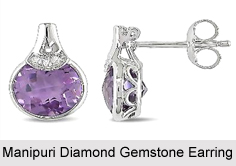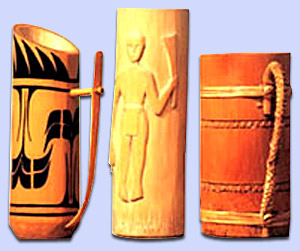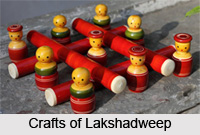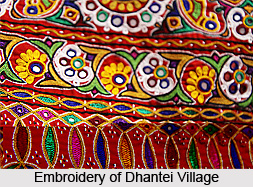 Gems are a part of ornaments and their value depends upon the finishing touch given to them by cutting. Gems are used for more purposes than merely beautification and in ornaments alone. Their varied purposes and objectives make gem cutting a significant craft, for which the northeast Indian state of Manipur is particularly well known along with the country as a whole. The term Manipur itself literally signifies land of gems. According to mythology, Pakhanba, the mythological character of Manipur appeared as a snake with a glowing gem on its head. Therefore, gems are a part of the mythological beliefs and culture of the land of Manipur, in addition to its name. Also, it is said that according to the Hindu version of the mythology, the land of Manipur was formerly named Mahindrapore or Mahindrapahar. But when a king named Raja Babru Baha (perhaps Babrubahana, the son of third Pandava Arjuna from Mahabharata and the princess of Manipur Chitrangada) came into possession of a jewel or gem which formerly belonged to the Naga Raja or serpent king, he changed the name of the land to Manipur, meaning the land of gem. According to Mahabharata however, the name Manipur was in existence before the birth of Babru Baha and Mahindrapore or Mahindrapahar was the name of a high hill situated at a short distance east of the capital, today known as Nongmaiching, meaning the hill that faces the sun. Another Hindu legend says the entire land was underwater when drained by Lord Shiva, the Hindu god of destruction, with the help of his trident. He performed a Rasa Lila with His consort Parvati while Pakhanba in the form of a snake appeared to provide light from his Mani or glowing gem on his head, thus the land was named Manipur. Therefore, gem is associated with the name of the land in many respects.
Gems are a part of ornaments and their value depends upon the finishing touch given to them by cutting. Gems are used for more purposes than merely beautification and in ornaments alone. Their varied purposes and objectives make gem cutting a significant craft, for which the northeast Indian state of Manipur is particularly well known along with the country as a whole. The term Manipur itself literally signifies land of gems. According to mythology, Pakhanba, the mythological character of Manipur appeared as a snake with a glowing gem on its head. Therefore, gems are a part of the mythological beliefs and culture of the land of Manipur, in addition to its name. Also, it is said that according to the Hindu version of the mythology, the land of Manipur was formerly named Mahindrapore or Mahindrapahar. But when a king named Raja Babru Baha (perhaps Babrubahana, the son of third Pandava Arjuna from Mahabharata and the princess of Manipur Chitrangada) came into possession of a jewel or gem which formerly belonged to the Naga Raja or serpent king, he changed the name of the land to Manipur, meaning the land of gem. According to Mahabharata however, the name Manipur was in existence before the birth of Babru Baha and Mahindrapore or Mahindrapahar was the name of a high hill situated at a short distance east of the capital, today known as Nongmaiching, meaning the hill that faces the sun. Another Hindu legend says the entire land was underwater when drained by Lord Shiva, the Hindu god of destruction, with the help of his trident. He performed a Rasa Lila with His consort Parvati while Pakhanba in the form of a snake appeared to provide light from his Mani or glowing gem on his head, thus the land was named Manipur. Therefore, gem is associated with the name of the land in many respects.
Several geologists have reported that there are deposits of precious stones and gems in Manipur, concentrated mostly in the Chandel and Ukhrul districts, which also used to procure raw and unfinished gems from Myanmar, a part of which the Kabow valley was a part of Manipur till handed over to Myanmar by the British under a treaty during the reign of Maharaja Gambhir Singh. It is reported that in Kabow valley as well, gems were available in raw form. Therefore, it was natural that the Meitheis developed an art of gem cutting in their own traditional way and it continued till the craft received necessary royal patronage, until languished when the patronage was withdrawn after the democratic set up. It is also because the traditional method did not ensure proper finish to acquire market as better finished gems from the rest of India flooded the market of Manipur.
The craft however, took a new turn perhaps in the late 80s or early 90s, when modern technology was introduced by a group of youths who were trained in gem cutting and gemmology, while the state government came forward to support them. The youngster group further trained girls in this craft by providing modern power driven machines with support from various financial organisations and institutions besides the industries department. Skilled as they were, the girls picked up the new methodology quickly to establish Manipur firmly on the map of gem cutting in India. One of the earliest units established in this craft was M/s Bhubon Gems, in Kakching in Thoubal district. The unit, even though left half starved without sufficient working capital, still takes the lead in propagating the concept and the craft, by providing necessary training inputs to girls from families falling under the Below Poverty Line.
The skill of gem cutting craft has developed so well in Manipur today that many gem dealers of Mumbai, Jaipur, Kolkata and Delhi are getting their gems finished in Manipur, bringing a much finer finish at cheaper rates. Often raw gems are sent to Manipur by air to get back finished gems also by air and even then it works out better both in quality and economically. Today, even in state capital Imphal market, the gems finished in Manipur occupy a greater share than yesteryears owing to their quality. The craft of Meithei girls has reached the level of international standards. It is reported that if insurgency in Manipur would not have reached up to alarming proportions, the state would have become one of the leading gem processors in the world. The activists need to see the danger they have put their own land into.
Where the traditional way of gem cutting has been either discarded or languished, for the reason they cannot deliver the quality needed for the market, the new technology has ultimately revolutionised this craft. In Manipur, it is credited to few enthusiastic youngsters who learnt the technology and resorted to promotions. It is worth noting that these youths while ensuring their own earning did not forget their social obligation to their land. They trained the local girls and ensured further employment generation. But they have their own problems too.
When a team of senior officers like Chief Manager, State Bank of India along with the Additional Director of Industries, Manipur and other officers from these two organisations visited M/s Bhubon Gems of Kakching, it was observed that the unit was financed by the Manipur Industrial Development Corporation, which financed their infrastructure like building, utilities, equipments and machines. But there was no provision made for the working capital nor had they requested any bank to extend cash credit facility. By the time the banks came forward, the loan was already overdue thus they had no other option than to keep quiet. Thus, the unit languished on account of under financing. The situation somehow could be contained by acquiring raw gems on credit and selling of finished gems. This is almost an identical situation in case of all gem cutting units in the state. Besides, these units need to meet demand from different enterprises draining a lot of hard earned money. As per R. K. Apoilo, one of the trained youngsters in gemmology, it is better and more feasible to establish a gem cutting unit in Delhi or Kolkata than in Manipur. The craft of the state, therefore, despite the skill shall languish unless appropriate inputs and impetus is given to it.
Related Articles:
Manipur
Crafts of Manipur
Stone Art, India
Tribes of Manipur
Gemstones
Significance of Gemstones
Imphal






